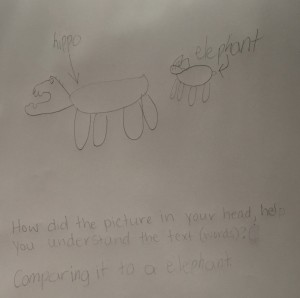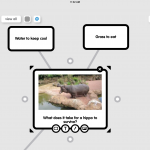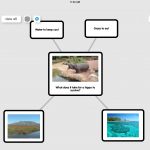Is it weird to have a fascination with hippos? I can’t say that I think they’re cute or that they’re my favorite animal, but they’re so peculiar – dare I say boring? Therefore, I am fascinated by people who would go out of their way to write a book about hippos. This same line of thinking is why I owned a pair of white patent leather platform pumps. The book purchase turned out to be a much better use of money.
Why I Finished It:
It is fascinating! Yes, a book about hippos is fascinating. Hippos are “huge,” they are “the most dangerous animal in Africa,” and “they swat balls of dung at each other.” I do not want to know how he figured that out, but I enjoyed the picture. Each page has a fabulous illustration by Matthew Trueman and one, possibly two, engaging and cleverly presented facts by Jonathan London. In large font, London explains a fact that the youngest of students can understand. For example, “Hippos are HUGE! Except for elephants, no other land animals are as large as hippopotamuses. They can weigh as much as fifty men!” What a visual! Then, on the same page, there is fine print. On this page it says, “A full-grown bull weighs up to 4 tons and can be 12 feet (almost 4 meters) long.” Love it! Each page follows the same format.
Who I Would Give It To:
All elementary teachers! Such a fabulous example of how nonfiction can be remarkable. Nonfiction picture books have come a long way and this one is no exception. It is vibrant, funny, descriptive, and packed with powerful learning.
Integration Ideas:
Writing – details and description (word choice) and visualization (sensory images)
With older grade teachers I am constantly pushing Seymour Simon as a “go to” mentor text for nonfiction descriptive writing, here is the elementary teacher’s “go to” mentor text for descriptive writing. Using the example given above, London doesn’t just say that hippos are HUGE! He explains what huge means. It means that no other land animal is as large and they can weigh as much as fifty men. Stop with the students here and read like writers (Katie Wood-Ray). Notice what the author did. Ask the students, “What do you notice?” Hopefully, the students will notice that the word huge is written larger, darker, and in all caps. Continue the discussion asking why the author did that. Lead the students into realizing that the author said they’re huge, but didn’t stop there. He continued to explain what huge meant. He painted a picture in the mind of the reader as to just how huge hippos are. Continue reading through the book, or choose specific pages and stop to read like a writer. In the end, have students add to their own writing. Have them explain in a couple of sentences what one of their comments or words means in order to paint a picture for their readers.
This lesson shows the reciprocal nature of reading and writing. Explain, that when writers write they use description and details to paint a picture for the reader, so as a reader, we must visualize or picture what the author is painting. Read some of the pages that London “paints”, without showing Trueman’s actual drawings. Ask students to close their eyes and visualize what the author is saying. Have students illustrate what they are picturing. As they draw, ask them to tell you what words or parts of the text made them visualize specific details in their drawing. Once complete, share Trueman’s drawing. Have students compare and contrast their visualization to the illustrators. (The example to the right is by a second grade student).
Science and Social Studies
Naturally, as this is a book about animals, this is a great time to discuss continents and their resources. Discuss animal adaptations and compare hippos to other animals. Could the hippo survive in other climates? What is necessary for a hippo to survive? Why does the hippo have such a large mouth? Hippos are on the Endangered Species list. What can we do to save the hippos?
Technology idea: This type of discussion calls for a mind map! Popplet is a great versatile tool that is easy to use and lets students easily create and visualize connections. Students can draw or insert pictures they already have, add text, and connect their ideas. You can start with any question or idea in the middle and go from there! For example, start with brainstorming what is necessary for a hippo to survive, and then bring in some different habitats and see which ones would work, making connections between the characteristics and the habitats.
Use a completed mind map as an outline for a research paper or presentation!
Research Unit
Have students choose an animal off the endangered species list to research. Check out how to make a Google Custom Search Engine and our favorite search engines to help with the research. Have students create a class book. Each student can write one fact on the page, support it with details, and possibly one more cited fact (similar to the author). Have each student illustrate their text with their visualization and put the pages together!
Technology idea: Create an endangered species ebook! Use an app like Book Creator to compile each student’s fact page. Students can draw their image on paper and take a picture to include in the book or take turns drawing directly on their page in the app. Add a layer of awesome by having students record a narration for their page. Students can also include videos and links to more information, if they want. When the book is finished, it can be downloaded as an ebook which can be added to iTunes store to be shared with parents and grandparents! If you don’t have access to iPads, you can use a site like FlipSnack, which is web-based and will produce a beautiful interactive book that can be viewed online with a shareable link.









I loved your blog and suggestions. The book appeals to me, because I love the illustration on the cover. I am a visual person, and at one time, many years ago I wanted to be a children’s author and illustrator. Thus, I love your suggestion to have the students close their eyes and visualize, then draw, as you read aloud the story. Even my kindergartners will be able to do that.
This book appeals to me that because I am a science teacher. I love hippos. I like using children’s books to create a hook in a lesson. It is something different and even High schools kids like it. It is a great way to introduce a lesson.
I think it is very interesting how you choose your books, I tend to be drawn to the covers and titles of books. I love the tips that you give us to tie in the research learning piece, so we can take it a step farther.
I really like your blog. You are very honest about why you chose it and why you finished it. I also really like that you tell me how you’d incorporate it into many different types of classrooms. Great job!
🙂
Please add me to your email list. I don’t want to miss any of your great ideas!